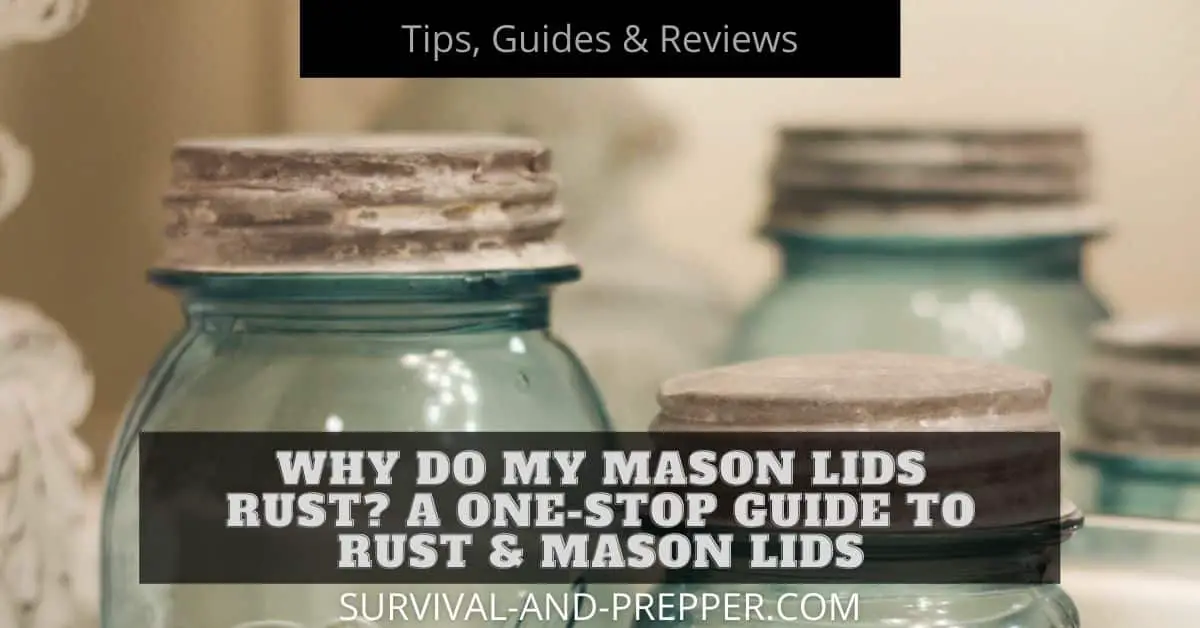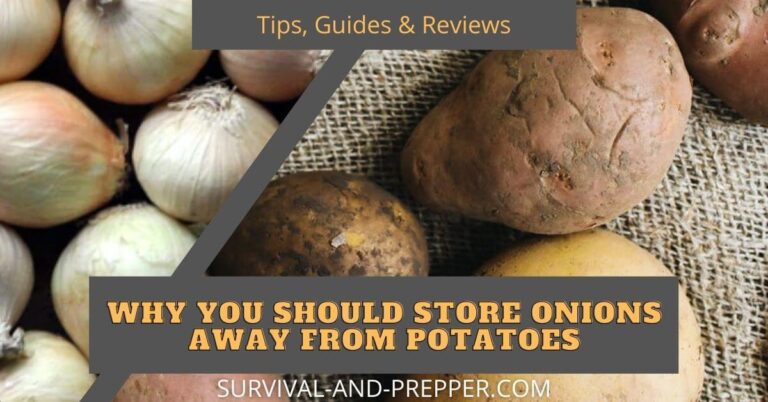Why Do My Mason Lids Rust? A One-Stop Guide to Rust & Mason Lids
Mason Jars have been around for over 150 years. While they are great for canning, storing food and about a million other uses. One thing that still plagues some people is rusted lids. This may lead you to wonder why did the lids rust? Are they still safe? How can I clean the rust off?
I have prepared a guide that I hope will answer all of these questions and more for you.
Why Do My Mason Jar Lids Rust?
Rust on mason jar lids is normally caused by moisture build up on the lids. This moisture reacts with the steel bands and begins to form Iron Oxide. In addition to moisture, many traditional canned goods contain a high level of acid which could cause the lids to begin rusting if not properly cleaned and stored.
The three most common sources of moisture build up on mason lids are left over water from the canning process, higher than normal humidity causing condensation to build up on the cold steel rings and water or liquids from other jars being spilled on the lids.
Most of these issues can be avoided by ensuring that your jars are completely dried after the canning process. You should also store them in a dark and dry cool environment with minimal temperature fluctuations. If it is necessary a dehumidifier can be used to reduce the moisture content of the air somewhat.
Basements work great for the cool dark area though if you are not careful they can be a bit damp and you should generally run a dehumidifier in your basement to combat this.
Is Rust on Mason Jar Lids Dangerous?
Rust on the lids is not dangerous in and of itself. It is really nothing more than iron oxide. However, the danger stems from possibly ingesting food that has spoiled due to a damaged lid. Care should be taken to inspect any jars which show signs of rust in order to determine if they remained sealed. If in doubt discard the contents.
The most common rust observed on lids is normally from the rings. This usually begins due to some moisture being trapped either in the rolled portion of the lip around the ring, or in the space between the ring and actual flat lid of the jar. Once the rust has begun to form it can rapidly expand to nearby areas on the ring and the lid.
While rust is nothing more than oxidized iron you should not consume more than a minute amount if any. Normally your body is able to get all of the iron it needs from the other foods you eat. However, if you ingest a small amount, don’t worry you aren’t going to get any magnets stuck to you.
As I mentioned before the real danger comes from a jar that is no longer properly sealed. If you are following best practices then the rings were removed after the canning process. This allows the lids to pop off and separate if their seal has broken. This prevents you from accidentally consuming food that may be contaminated with botulism or other nasty bacteria.
Most modern jar lids designed for canning are coated with a rubber like substance on the bottom side that helps prevent the acidic foods inside of the jar from corroding the lids. However, if exposed to rust from the outside and left unchecked, it is possible that the rust could eat partially or completely through the lid.
This could lead to air contaminating the foods inside and allowing bacteria to grow. This is the primary reason that most recommendations are to discard any food with rusted lids. Though a small amount of rust is not likely harmful. If you do discover any then either consume or discard the contents in a timely manner.
How Can I Prevent My Jar Lids from Rusting?
Removing the rings, completely drying the jars after the canning process, applying a small amount of cooking oil to the lids and storing the jars in a dry environment are the best ways to prevent the lids from rusting.
Whether you are canning using a steam, pressure or water bath canning it is critical that you ensure the jars are completely dry after the process is complete. This can be accomplished by drying the jars with a clean cloth and placing them in front of a fan or other moving air source while they cool down.
Another tactic I like to take is to place a small amount of olive oil or other cooking oil on a clean cloth and wipe it onto the lids. I then wipe them off again. This leaves a slight protective film without leaving the jars with an oily feel.
Last ensure that your jars are stored in a dry area with stable temperatures. Even though many basement areas are susceptible to moisture, in most cases this is not enough to harm the jars. Just try to ensure there are not large variations in temperature that could cause condensation to form on the lids.
How Do I Get Rust off of My Canning Lids?
Generally speaking you should not reuse rusted mason jar lids. However, if you are using them for non canning purposes then you can clean the rust off of the lids and rings with one of the following methods.
Oftentimes you can rinse off minor amounts of rust with simple soap and water. Just remember to dry them completely afterwards.
You can use a scouring pad commonly used for metal pots and pans. In most cases these will remove any minor signs of rust with little issue. However, keep in mind this breaks the coating that canning lids and rings normally have on them. Once that happens they become more susceptible to rust after this point.
Are There Canning Lids That Do Not Rust?
Traditional canning lids are made from steel which does tend to rust.
However, there are at least two options for rust proof mason jar lids. These options include stainless steel lids and plastic lids. While the stainless steel can be used for traditional canning the plastic options are only for use if you do not intend to actually can the contents and simply want to store something in the jar.
These plastic style lids are ideal if you intend on freezing the contents of your mason jars.
Stainless Steel Lids
Stainless steel lids function in the same manner as traditional lids. You can can with them using pressure, water bath and steam canning. Despite the fact that these lids are unlikely to rust it is important that you remove the ring after the canning process is complete.
Remember the removal of the ring assists with detecting a bad seal and helps to verify the jar is still sealed.
Plastic Mason Jar Lids
Plastic mason jar lids however are not suitable for canning. They can be used for storing stuff that you intend to freeze or even some dry ingredients such as corn, flour etc.
Besides just material, another difference with plastic lids is that frequently they come as one piece mason jar lids. This makes them far simpler to use and easier to store since you don’t risk losing parts. You can either purchase plastic lids from Amazon or you can recycle your own by saving the lids from mayonnaise, peanut butter and instant coffee jars depending on your needs.
One of the most popular options are iLids. These lids fit smaller jars with 2.75 inch mouths and feature a closable top. They make excellent drink lids if you enjoy drinking from your mason jars.
A last option is known as a Tattler lid. These reusable canning lids are made from a food grade plastic with a nitrile rubber gasket. These were first developed in 1976 and can be used in traditional canning. They are designed for both water bath and pressure canning and are one of the few plastic lids that are considered safe for these methods.
Due to their design tattler lids consist of three pieces and tend to be considerably more expensive than traditional metal rings and lids. However, since they are reusable they may be worth the added expense if you frequently can and have a reason to reuse jars.







One Comment